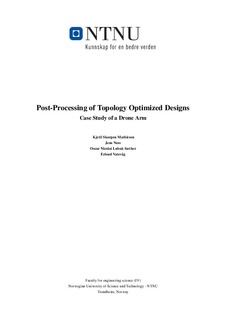| dc.contributor.advisor | Tyflopoulos, Evangelos | |
| dc.contributor.author | Mathiesen, Kjetil Skorpen | |
| dc.contributor.author | Ness, Jens | |
| dc.contributor.author | Sæther, Oscar Nicolai Løbak | |
| dc.contributor.author | Vatsvåg, Erlend | |
| dc.date.accessioned | 2019-09-06T14:05:58Z | |
| dc.date.available | 2019-09-06T14:05:58Z | |
| dc.date.issued | 2019 | |
| dc.identifier.uri | http://hdl.handle.net/11250/2613426 | |
| dc.description.abstract | Topologioptimalisering er en matematisk prosess som bidrar til å optimalisere design ved å fjerne unødvendig masse. Det finnes flere matematiske algoritmer for topologioptimalisering som blir brukt i kombinasjon med dataassistert konstruksjon. Tre av disse metodene har blitt undersøkt, testet og sammenliknet ved hjelp av en simpel 3D-figur.
Topologioptimalisete deler har en tendens til å ende opp med problematisk geometri, noe som gjør det vanskelig å produsere dem uten etterbehandling. På bakgrunn av dette, har denne oppgaven tatt for seg ulike metoder for etterbehandling. Gruppen har også undersøkt og utarbeidet ulike metoder, for hvordan å kunne gå fra et topologioptimalisert resultat, til et ferdig design. Disse metodene er forklart i detalj i denne bacheloroppgaven. I tillegg ble det undersøkt hvordan størrelsen på det tilgjengelige designområdet kan påvirke topologioptimaliseringsresultater.
For å bruke den tillærte kunnskapen og de forskjellige metodene, ble et samarbeid med Sevendof igangsatt. Sevendof er et firma som produserer industrielle droner, som trenger å være så lette som mulig. Oppgaven gruppen ble tildelt var å bruke topologioptimalisering for å gjøre en dronearm lettere. Sevendof ga gruppen noen kriterier som dronearmen måtte oppfylle. Dronearmen ble redesignet, topologioptimalisert, etterbehandlet og validert ved bruk av dataassistert konstruksjon.
Sevendof presenterte to ulike scenarioer for dronearmen. Load case 1 og load case 2. Det førstnevnte scenarioet representerer kreftene utøvd av motoren, ved full effekt, på armen. Dronearmen ble designet ut ifra disse påkjenningene. Load case 2 representerer en kritisk situasjon som ble undersøkt. | |
| dc.description.abstract | Topology optimization is a mathematical process that alters the shape and material distribution of a design. It is implemented in combination with computer-aided design and finite element analysis. Topology optimization contributes to solving basic engineering problems: reducing weight and maximizing stiffness. The topology optimized results will often be rough, and therefore have to be post-processed to obtain good result. This process consists of evaluating the results, re-designing the part and then validating the new optimized design.
In this assignment a literature research about some of the currently available topology optimization algorithms has been conducted. In addition, topology optimization using lattice structures has been researched. Different programs utilizing these algorithms were then tested. These programs were tested using a simple 3D model and then compared against each-other using the same parameters. The programs were ranked based on the results, solver time, general overview and ease of use and then compared.
Several methods for post-processing of the topology optimized results were researched and devised. These are explained in this thesis. Research on how the design space of a model affects the topology optimization results were also conducted. The research conducted was then utilized on a case study. The case study was provided by the company Sevendof, who develops industrial service drones. To increase flight time, these drones should be as light as possible. The purpose of the case study is to utilize topology optimization to save as much weight a possible on the drone arm while meeting the design and structural requirements. Sevendof supplied a set of load cases. Load case 1 is based on the maximum thrust of the motors and is used to optimize the drone arm. Load case 2 describes a critical failure. Studies will be conducted to provide data on this scenario. A rough design outline of the drone arm was provided as a starting point. The arm was re-designed, topology optimized, post-processed and then validated to meet the conditions set by Sevendof. | |
| dc.language | eng | |
| dc.publisher | NTNU | |
| dc.title | Post-Processing of Topology Optimized Designs Case Study of a Drone Arm | |
| dc.type | Bachelor thesis | |
